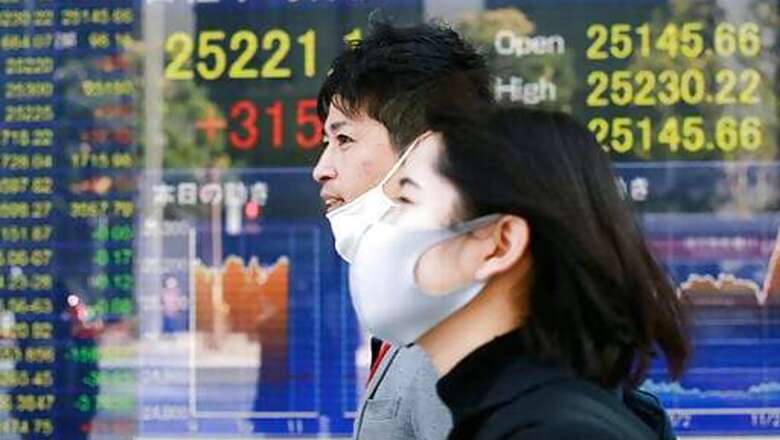
views
NEW YORK: Another rally for the S&P 500 on Wednesday is sending it to the edge of its record high, and this time big technology stocks are also rising on Wall Street.
The benchmark index was 0.9% higher in afternoon trading at 3,576, nearing its all-time high of 3,580.94 set in September.
The Dow Jones Industrial Average was also flirting with its own record, which was set before the pandemic sent the economy and markets crashing. It was up 88 points, or 0.3% , at 29,508, as of 1 pm. Eastern time, approaching its record of 29,551.42. The Nasdaq composite, meanwhile, was leading the market with a gain of 1.8%.
Enthusiasm about the economys possible return to normal has vaulted stocks higher this week following encouraging, but incomplete data on a potential vaccine for COVID-19. That pushed investors to shift dollars out of the old winners of the stay-at-home, virus-wracked economy and into beaten-down stocks that have a brighter future if people feel comfortable again going outside their homes.
Big Tech stocks had borne the brunt of this weeks dramatic reordering, but they clawed back some of those earlier losses. Microsoft rose 2.8%, cutting its loss for the week to 3%, for example. Amazon gained 2.8% to pare its weekly loss to 5.8%.
Elsewhere in the market, some of the massive rotation that swept through early this week also eased off the accelerator. The S&P 500 was nearly evenly split between stocks rising and falling, while energy and bank stocks gave back a bit of their huge gains from Monday and Tuesday. Stocks of smaller companies, which tend to move more with expectations for the economy, were also lagging the market, and the Russell 2000 index of small-cap stocks was down 0.3%.
Some prospective new winners of a post-vaccine economy were continuing to climb.
Lyft rose 2% after its results for the latest quarter showed signs of a recovery in its ride-hailing business. Revenue plunged by nearly half in the summer from a year earlier, but it was nowhere near as bad as during the spring, when lockdowns were at full force.
While several significant risks remain for Wall Street broadly, the optimistic case that investors are embracing is that one or more coronavirus vaccines could help corral the virus by the second half of next year, encouraging people to return to life as it was before the pandemic.
All that economic activity would come on top of the tremendous aid that the Federal Reserve and other central banks around the world are pumping into the economy through very low interest rates and massive purchases of bonds. Hope also remains that the U.S. government may eventually deliver some form of support for the economy, though its total size would likely be smaller than if Democrats had swept this months elections.
Strategists along Wall Street are raising their forecasts for stock prices on expectations that political control of Washington will remain split between the parties. Republicans look set to keep the Senate, as long as runoff elections go their way in Georgia in January, while Democrats will hold the House of Representatives.
Democrat Joe Biden has clinched enough electoral votes to win the White House, clearing some of the uncertainty that weighed on the market through the vicious campaign. Even though President Donald Trump has refused to concede, investors are ignoring his complaints so far. Theyre instead working on the assumption that a split Washington under Biden could keep tax rates low while offering more steady and predictable policies.
Those expected results helped push strategists at Goldman Sachs to raise their forecast for the S&P 500 at the end of this year to 3,700 from 3,600. That would imply another 4.4% climb from Tuesdays closing level. They expect it to rally another 16% through 2021. But the biggest driver for that is the hope for a return to normal life, rather than what happens in Washington.
A vaccine is a more important development for the economy and markets than the prospective policies of a Biden presidency, the Goldman Sachs strategists, led by David Kostin, said in a report.
Of course, several pessimistic cases also still hang over the market. One or more could ultimately derail whats been a 9% rally for the S&P 500 already in November.
Chief among them is the continuing climb in coronavirus counts. Medical experts warn a difficult winter is approaching, and several European governments have already brought back restrictions on businesses to slow the spread of the virus there.
In the United States, Texas has become the first state with more than 1 million confirmed coronavirus cases. Even if the strictest lockdown measures dont return to the United States, the worry is that scared customers will stay away from businesses regardless and undercut profits.
And even though early indicators have been encouraging about a potential coronavirus vaccine, theres no guarantee one will ultimately be available or when.
Trading in the U.S. bond market is closed for Veterans Day, after Treasury yields climbed this week on hopes for a healthier economy and expectations that could lead to a pickup in inflation. The yield on the 10-year Treasury is close to its highest level since March.
In European stock markets, Frances CAC 40 rose 0.5%, and Germanys DAX returned 0.4%. The FTSE 100 in London gained 1.4%.
In Asia, Japans Nikkei 225 rose 1.8%, and South Koreas Kospi strengthened by 1.3%. But stocks slipped in Shanghai and Hong Kong after Chinese regulations focused on technology companies pulled shares in big technology companies like Alibaba and Tencent sharply lower.
___
AP Business Writers Joe McDonald and Elaine Kurtenbach contributed.
Disclaimer: This post has been auto-published from an agency feed without any modifications to the text and has not been reviewed by an editor
Read all the Latest News, Breaking News and Coronavirus News here


















Comments
0 comment